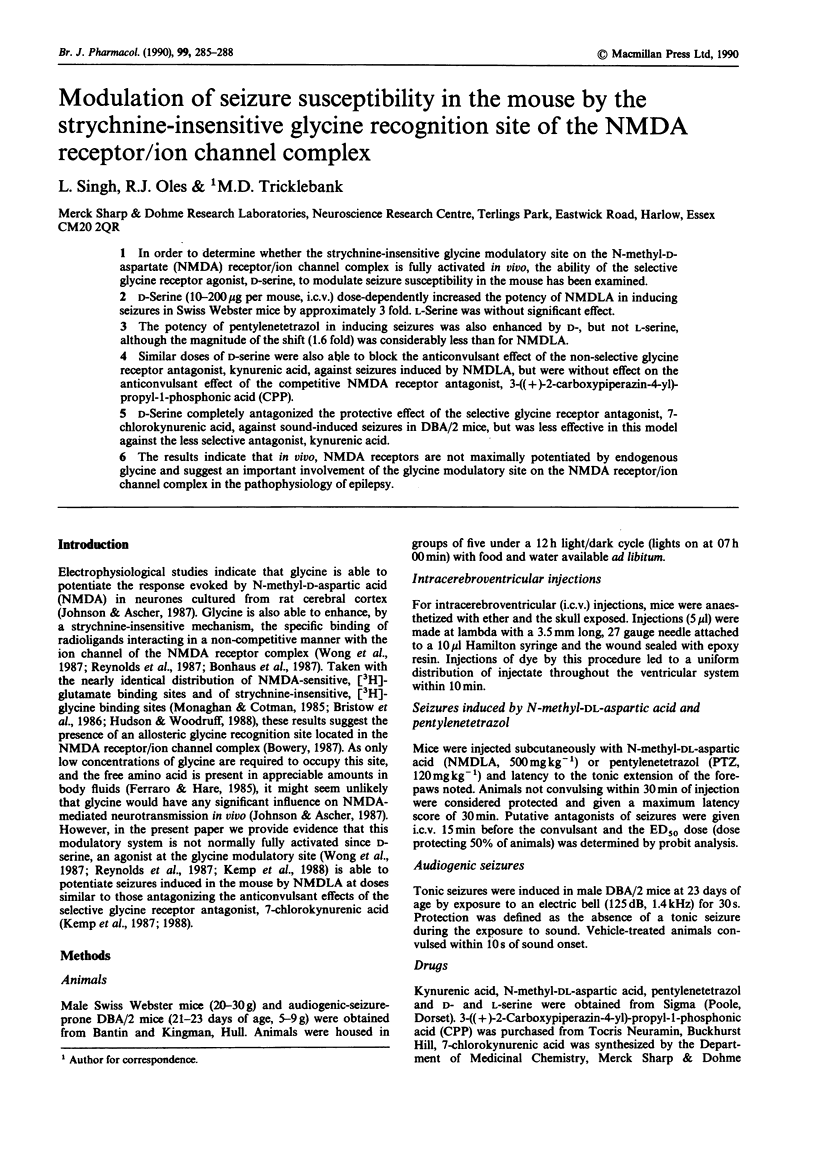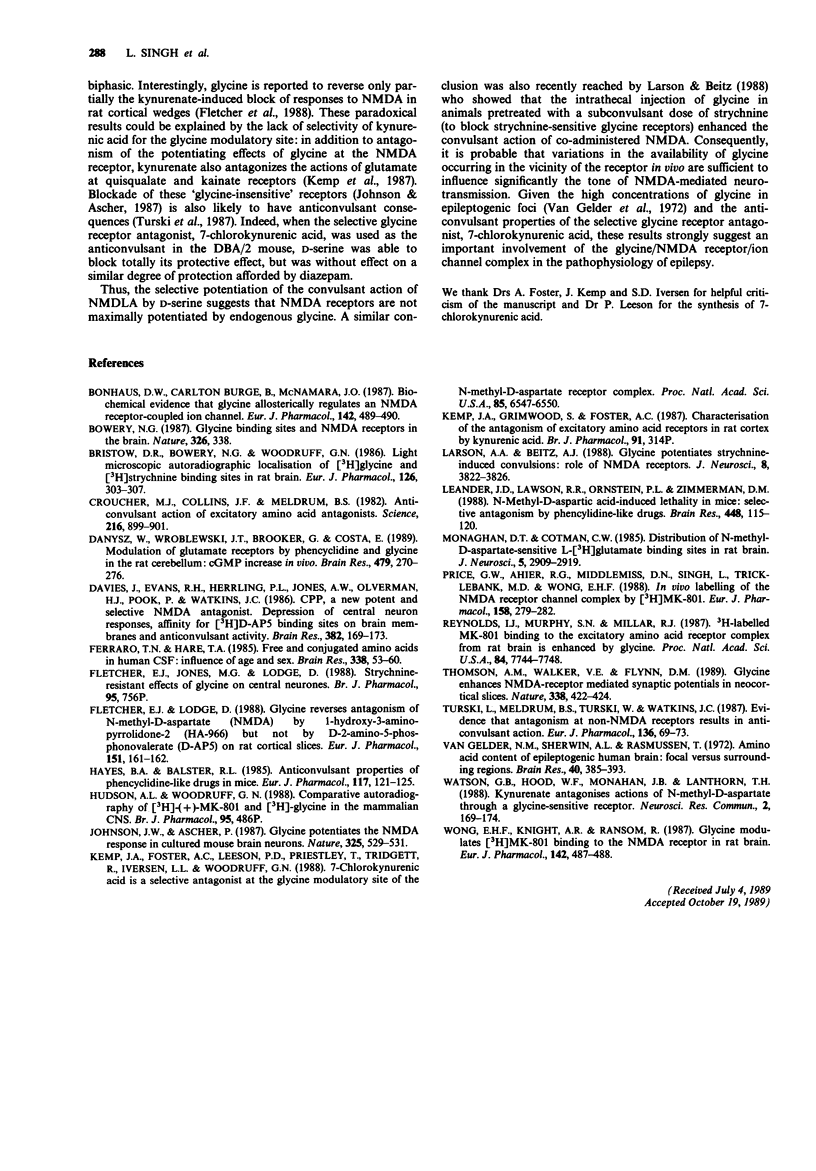Abstract
1. In order to determine whether the strychnine-insensitive glycine modulatory site on the N-methyl-D-aspartate (NMDA) receptor/ion channel complex is fully activated in vivo, the ability of the selective glycine receptor agonist, D-serine, to modulate seizure susceptibility in the mouse has been examined. 2. D-Serine (10-200 micrograms per mouse, i.c.v.) dose-dependently increased the potency of NMDLA in inducing seizures in Swiss Webster mice by approximately 3 fold. L-Serine was without significant effect. 3. The potency of pentylenetetrazol in inducing seizures was also enhanced by D-, but not L-serine, although the magnitude of the shift (1.6 fold) was considerably less than for NMDLA. 4. Similar doses of D-serine were also able to block the anticonvulsant effect of the non-selective glycine receptor antagonist, kynurenic acid, against seizures induced by NMDLA, but were without effect on the anticonvulsant effect of the competitive NMDA receptor antagonist, 3-((+)-2-carboxypiperazin-4-yl)-propyl-1-phosphonic acid (CPP). 5. D-Serine completely antagonized the protective effect of the selective glycine receptor antagonist, 7-chlorokynurenic acid, against sound-induced seizures in DBA/2 mice, but was less effective in this model against the less selective antagonist, kynurenic acid. 6 The results indicate that in vivo, NMDA receptors are not maximally potentiated by endogenous glycine and suggest an important involvement of the glycine modulatory site on the NMDA receptor/ion channel complex in the pathophysiology of epilepsy.
Full text
PDF



Selected References
These references are in PubMed. This may not be the complete list of references from this article.
- Bonhaus D. W., Burge B. C., McNamara J. O. Biochemical evidence that glycine allosterically regulates an NMDA receptor-coupled ion channel. Eur J Pharmacol. 1987 Oct 27;142(3):489–490. doi: 10.1016/0014-2999(87)90096-3. [DOI] [PubMed] [Google Scholar]
- Bowery N. G. Glycine-binding sites and NMDA receptors in brain. 1987 Mar 26-Apr 1Nature. 326(6111):338–338. doi: 10.1038/326338a0. [DOI] [PubMed] [Google Scholar]
- Bristow D. R., Bowery N. G., Woodruff G. N. Light microscopic autoradiographic localisation of [3H]glycine and [3H]strychnine binding sites in rat brain. Eur J Pharmacol. 1986 Jul 31;126(3):303–307. doi: 10.1016/0014-2999(86)90062-2. [DOI] [PubMed] [Google Scholar]
- Croucher M. J., Collins J. F., Meldrum B. S. Anticonvulsant action of excitatory amino acid antagonists. Science. 1982 May 21;216(4548):899–901. doi: 10.1126/science.7079744. [DOI] [PubMed] [Google Scholar]
- Danysz W., Wroblewski J. T., Brooker G., Costa E. Modulation of glutamate receptors by phencyclidine and glycine in the rat cerebellum: cGMP increase in vivo. Brain Res. 1989 Feb 13;479(2):270–276. doi: 10.1016/0006-8993(89)91628-4. [DOI] [PubMed] [Google Scholar]
- Davies J., Evans R. H., Herrling P. L., Jones A. W., Olverman H. J., Pook P., Watkins J. C. CPP, a new potent and selective NMDA antagonist. Depression of central neuron responses, affinity for [3H]D-AP5 binding sites on brain membranes and anticonvulsant activity. Brain Res. 1986 Sep 10;382(1):169–173. doi: 10.1016/0006-8993(86)90127-7. [DOI] [PubMed] [Google Scholar]
- Ferraro T. N., Hare T. A. Free and conjugated amino acids in human CSF: influence of age and sex. Brain Res. 1985 Jul 8;338(1):53–60. doi: 10.1016/0006-8993(85)90247-1. [DOI] [PubMed] [Google Scholar]
- Fletcher E. J., Lodge D. Glycine reverses antagonism of N-methyl-D-aspartate (NMDA) by 1-hydroxy-3-aminopyrrolidone-2 (HA-966) but not by D-2-amino-5-phosphonovalerate (D-AP5) on rat cortical slices. Eur J Pharmacol. 1988 Jun 22;151(1):161–162. doi: 10.1016/0014-2999(88)90711-x. [DOI] [PubMed] [Google Scholar]
- Hayes B. A., Balster R. L. Anticonvulsant properties of phencyclidine-like drugs in mice. Eur J Pharmacol. 1985 Oct 29;117(1):121–125. doi: 10.1016/0014-2999(85)90480-7. [DOI] [PubMed] [Google Scholar]
- Johnson J. W., Ascher P. Glycine potentiates the NMDA response in cultured mouse brain neurons. Nature. 1987 Feb 5;325(6104):529–531. doi: 10.1038/325529a0. [DOI] [PubMed] [Google Scholar]
- Kemp J. A., Foster A. C., Leeson P. D., Priestley T., Tridgett R., Iversen L. L., Woodruff G. N. 7-Chlorokynurenic acid is a selective antagonist at the glycine modulatory site of the N-methyl-D-aspartate receptor complex. Proc Natl Acad Sci U S A. 1988 Sep;85(17):6547–6550. doi: 10.1073/pnas.85.17.6547. [DOI] [PMC free article] [PubMed] [Google Scholar]
- Larson A. A., Beitz A. J. Glycine potentiates strychnine-induced convulsions: role of NMDA receptors. J Neurosci. 1988 Oct;8(10):3822–3826. doi: 10.1523/JNEUROSCI.08-10-03822.1988. [DOI] [PMC free article] [PubMed] [Google Scholar]
- Leander J. D., Lawson R. R., Ornstein P. L., Zimmerman D. M. N-methyl-D-aspartic acid-induced lethality in mice: selective antagonism by phencyclidine-like drugs. Brain Res. 1988 May 10;448(1):115–120. doi: 10.1016/0006-8993(88)91107-9. [DOI] [PubMed] [Google Scholar]
- Monaghan D. T., Cotman C. W. Distribution of N-methyl-D-aspartate-sensitive L-[3H]glutamate-binding sites in rat brain. J Neurosci. 1985 Nov;5(11):2909–2919. doi: 10.1523/JNEUROSCI.05-11-02909.1985. [DOI] [PMC free article] [PubMed] [Google Scholar]
- Price G. W., Ahier R. G., Middlemiss D. N., Singh L., Tricklebank M. D., Wong E. H. In vivo labelling of the NMDA receptor channel complex by [3H]MK-801. Eur J Pharmacol. 1988 Dec 13;158(3):279–282. doi: 10.1016/0014-2999(88)90080-5. [DOI] [PubMed] [Google Scholar]
- Reynolds I. J., Murphy S. N., Miller R. J. 3H-labeled MK-801 binding to the excitatory amino acid receptor complex from rat brain is enhanced by glycine. Proc Natl Acad Sci U S A. 1987 Nov;84(21):7744–7748. doi: 10.1073/pnas.84.21.7744. [DOI] [PMC free article] [PubMed] [Google Scholar]
- Thomson A. M., Walker V. E., Flynn D. M. Glycine enhances NMDA-receptor mediated synaptic potentials in neocortical slices. Nature. 1989 Mar 30;338(6214):422–424. doi: 10.1038/338422a0. [DOI] [PubMed] [Google Scholar]
- Turski L., Meldrum B. S., Turski W. A., Watkins J. C. Evidence that antagonism at non-NMDA receptors results in anticonvulsant action. Eur J Pharmacol. 1987 Apr 7;136(1):69–73. doi: 10.1016/0014-2999(87)90780-1. [DOI] [PubMed] [Google Scholar]
- Van Gelder N. M., Sherwin A. L., Rasmussen T. Amino acid content of epileptogenic human brain: focal versus surrounding regions. Brain Res. 1972 May 26;40(2):385–393. doi: 10.1016/0006-8993(72)90141-2. [DOI] [PubMed] [Google Scholar]
- Wong E. H., Knight A. R., Ransom R. Glycine modulates [3H]MK-801 binding to the NMDA receptor in rat brain. Eur J Pharmacol. 1987 Oct 27;142(3):487–488. doi: 10.1016/0014-2999(87)90095-1. [DOI] [PubMed] [Google Scholar]


